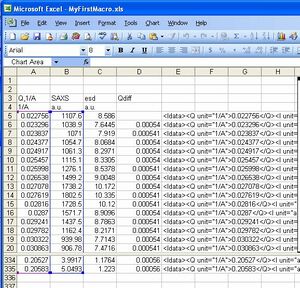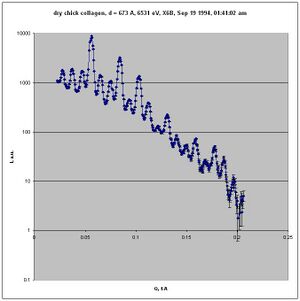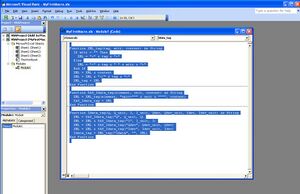cansas1d casestudy collagen
Overview
To demonstrate how to get SAS data into the XML standard format, consider this set of SAXS data collected at the National Synchrotron Light Source, Brookhaven National Laboratory, using a SAXS camera set up temporarily at beam line X6B (operated by the Materials Science Division, Argonne National Lab).
The sample was dry chick collagen. (Thanks to Malcolm Capel, NSLS beam line X12C for the sample.)
The raw data was collected on a linear position-sensitive detector and reduced to columns of Q, I, and Iesd (estimated standard deviation of I).
The only metadata available for this data (without resorting to digging through piles of old notebooks) was obtained from two file headers:
Sep 19 1994 01:41:02 am Elt: 00090 Seconds ID: No spectrum identifier defined Memory Size: 8192 Chls Conversion Gain: 1024 Adc Offset: 0000 Chls
dry chick collagen, d = 673 A 6531 eV, X6B
But, the data can fulfill the minimum requirements of the 1D standard file format and also make an excellent example of a minimal canSAS reduced 1-D SAS data file in XML.
Procedure
make the basic XML file
It is easiest to copy a template rather than start from an empty file. Copy the cansas1d.xml file into your working directory and rename it to collagen.xml.
modify collagen.xml
It is easier to see the metadata in the XML file before you enter the SAXS data into the file. With the brief metadata available, most lines can be eliminated. This will result in a file that looks like
<?xml version="1.0"?>
<?xml-stylesheet type="text/xsl" href="example.xsl" ?>
<SASroot version="1.0"
xmlns="cansas1d/1.0"
xmlns:xsi="http://www.w3.org/2001/XMLSchema-instance"
xsi:schemaLocation="cansas1d/1.0 http://svn.smallangles.net/svn/canSAS/1dwg/trunk/cansas1d.xsd"
>
<SASentry>
<Title>dry chick collagen, d = 673 A, 6531 eV, X6B</Title>
<Run />
<SASdata>
<!-- Idata lines will go here -->
</SASdata>
<SASsample>
<ID>dry chick collagen, d = 673 A, 6531 eV, X6B</ID>
</SASsample>
<SASinstrument>
<name>X6B, NSLS, BNL</name>
<SASsource>
<radiation>X-ray synchrotron</radiation>
<wavelength unit="A">
1.898
<!-- = 12398/6531 -->
</wavelength>
</SASsource>
<SAScollimation />
<SASdetector>
<name>X6B PSD</name>
</SASdetector>
</SASinstrument>
<SASnote>
Sep 19 1994 01:41:02 am Elt: 00090 Seconds
ID: No spectrum identifier defined
Memory Size: 8192 Chls Conversion Gain: 1024 Adc Offset: 0000 Chls
dry chick collagen, d = 673 A
6531 eV, X6B
</SASnote>
</SASentry>
</SASroot>
prepare the SAXS data
Microsoft Excel is used here to convert the table of SAXS data into the required lines of XML for the standard. Some may prefer to use a cell formula but here, we develop a bit of Excel Macro code to clarify our procedure.
Excel macros used
Within Excel, with the SAXS data in columns as shown above (Media:Cs-collagen-data-table-Excel.jpg), let's define the macros for our use. In Excel, type <alt><F11> to open the macro editing window.
Function XML_tag(tag, attr, content) As String
If attr = "" Then
XML = "<" & tag & ">"
Else
XML = "<" & tag & " " & attr & ">"
End If
XML = XML & content
XML = XML & "</" & tag & ">"
XML_tag = XML
End Function
Function SAS_Idata_tag(element, unit, content) As String
XML = XML_tag(element, "unit=""" & unit & """", content)
SAS_Idata_tag = XML
End Function
Function Idata_tag(Q, Q_unit, I, I_unit, Idev, Idev_unit) As String
XML = SAS_Idata_tag("Q", Q_unit, Q)
XML = XML & SAS_Idata_tag("I", I_unit, I)
XML = XML & SAS_Idata_tag("Idev", Idev_unit, Idev)
Idata_tag = XML_tag("Idata", "", XML)
End Function
Your window will look similar to this one when you copy/paste the above code:
(Yes, my spreadsheet is called MyFirstMacro.xls)
Now close the macro editing window and return to the SAXS data in the spreadsheet.
construct the Idata lines in XML
move to spreadsheet cell E5 and enter this formula
=IDATA_tag(A5,$A$4,B5,$B$4,C5,$C$4)
Copy it down through cell E335
Select cells E5:E335 and copy to clipboard, then paste into collagen.xml document inside the SASdata element where you see the XML comment <!-- Idata lines will go here -->.
Final Result
A nicely-formatted display version of the final result can be viewed through the TRAC repository: http://svn.smallangles.net/trac/canSAS/browser/1dwg/trunk/cs_collagen_full.xml
Validate your file
So you think you have an XML file. Let's validate it using the procedure from the documentation. All the instructions are on the documentation page. No sense in repeating them here.
References
All files are available at http://svn.smallangles.net/trac/canSAS/browser/1dwg/trunk/examples/collagen/


